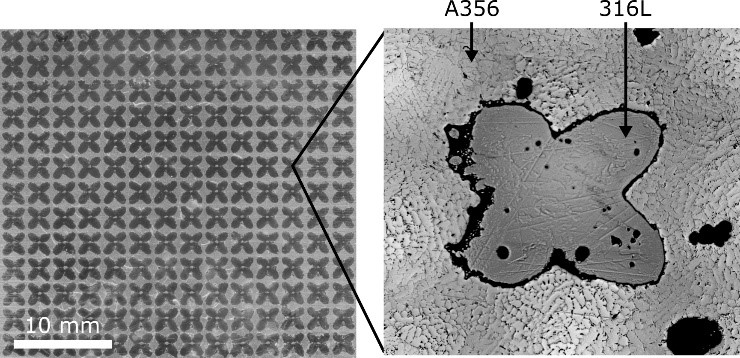
Oak Ridge National Laboratory and Rice University have developed a new manufacturing method that combines 3D printing with traditional casting in order to produce damage-tolerant components composed of multiple materials. The A356/316L composite components have showed a significantly greater damage tolerance than aluminum alone.
“This scalable processing strategy can be used to fulfill specific component functions, giving materials designers unprecedented control over both microstructure and material properties,” said Amit Shyam from ORNL.
Developed for potential automotive and other applications where thermal and mechanical properties must be optimized simultaneously, the process involves pouring molten A356 aluminum alloy over a 3D-printed 316L steel lattice.

The results of the research project, titled “Damage-tolerant metallic composites via melt infiltration of additively manufactured preforms,” have been published in Materials and Design. It highlights the two-step process route for fabricating metallic interpenetrating phase composites, and shows that the composites exhibit tailorable thermal and mechanical properties and exceptional damage tolerance due to microcracking and crack bridging.
The abstract for the published paper reads:
A356/316L interpenetrating phase composites were fabricated by infiltrating additively manufactured 316L lattices with molten A356.Measurements of the thermal conductivity of the composites showed an inverse rule-of-mixtures dependence on the 316L volume fraction. Compression tests revealed that the stress-strain response of the composites can be tailored by adjusting both the volume fraction and the topology of the 316L reinforcement. Tension tests on composites with 39 vol% 316L showed a strain to failure of 32%, representing an order of magnitude improvement over the strain to failure of monolithic A356. Inspection of the as-tested tensile specimens suggested that this exceptional damage tolerance is a result of the interpenetrating structure of the constituents. These results together demonstrate that this infiltration processing route avoids problems with intermetallic formation, cracking, and poor resolution that limit current fusion-based additive manufacturing techniques for printing metallic composites.
